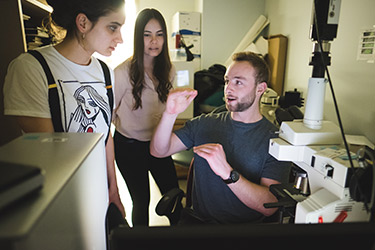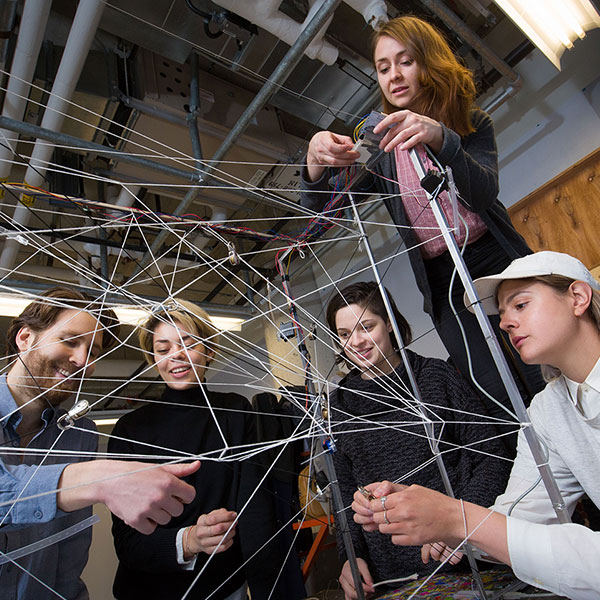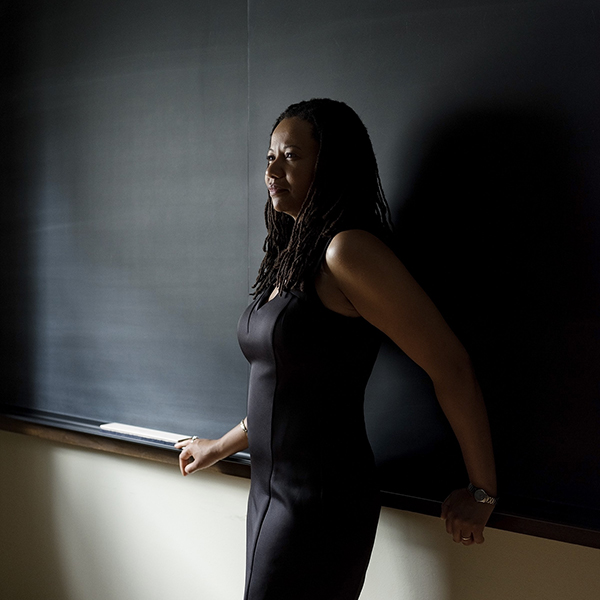Steve Beukema, a McGill PhD candidate in neuroscience, is standing in front of a room filled with artists and fellow scientists, talking about the way our senses work.
The manner in which our brains interpret information about the world around us isn’t a straightforward process – and that’s a subject of keen interest for both neuroscientists and artists.
Beukema, part of the McGill University Health Centre Research Institute’s Brain Repair and Integrative Neuroscience Program (BRaIN), clicks to his next slide. It’s an image of a Rubik’s cube. The top of the cube is bathed in light, and the side is obscured by a shadow. Beukema draws attention to one square on the top of the cube, and another on the side. The square on the top looks brown; the square on the side appears to be orange.
“We are given contextual information that leads us to make an interpretation about two seemingly very different colours,” says Beukema. “But when we remove the context guiding our interpretations, we reveal the objective reality of the situation—the colours are in fact identical.”
Beukema’s point is simple: our brains do not simply make a copy of the world, and our senses are incomplete without the experiences, expectations and interpretations that guide us.
The artists in attendance are there because they want to get a better understanding of how neuroscientists like Beukema see the world. Their ultimate goal is to be able to interpret his work – or the work of one of the other graduate students at BRaIN – in an artistic way.
Beukema and his audience are all part of a unique collaboration between McGill neuroscience trainees and Concordia fine art students called Convergence: Perceptions of Neuroscience. On the project’s site, it offers this definition for convergence: “the process by which two different elements merge together into a unified whole.”
The next presenter is Hunter Shaw, BSc’13, also a McGill doctoral student affiliated with BRaIN. He too addresses the manner in which our senses work. The world is full of data, says Shaw, but humans only possess a limited number of decryption tools.
In the world of comics, we often imagine individuals possessing superhuman senses—echolocation for Daredevil, or polarization for Ant-Man, for example. In the real world, these aren’t just fantastical super powers.
Many of the animals that share our environment have developed these special senses. Bats and whales use echolocation to find food and locate themselves in relation to other creatures and objects; ants use polarized light to navigate home after a day of foraging; turtles and birds use magnetoreception during their annual migrations; and sharks and platypuses use electroreception to seek out food.
“I think that the take-home message is that there is all this information out there in the world, in the universe, and what we detect as humans is just a very small sliver of what’s out there,” says Shaw. Both science and art provide tools for figuring out what we might be missing.
The Convergence project brings together 17 BRaIN trainees and 28 students from Concordia’s Faculty of Fine Arts to create works of art inspired by the trainees’ research projects.
The idea originated with BRaIN research associate Cristian Zaelzer. He wanted to group together artists and scientists with the goal of using art as a tool to explain complex concepts in neuroscience. The neuroscientists would gain an opportunity to see their work anew, through artists’ eyes, and the artists would have a chance to see, up close, how scientific research is pursued. Zaelzer spoke to BRaIN manager Andrée Lessard about the idea and she soon became an enthusiastic partner.
They approached Concordia dean of fine arts Rebecca Duclos. In January, Concordia launched the first iteration of a fourth-year independent study course, allowing undergraduate artists to earn credits for their collaborative work with BRaIN researchers.

Shaw, whose research focuses on the visual structures of fruit flies, has teamed up with Alexa Piotte, a graphic artist, and Paméla Simard, a sculptor who usually works with wood. Piotte plans to use a laser printing technique to etch images onto plexiglass sheets; then, she will superimpose the sheets to represent the layering of different levels of the fruit fly’s visual system—synaptic, cellular, anatomical, and, finally, behaviour. Simard plans to construct a wooden structure that will illuminate the fruit fly’s visual structure.
“For me, before this project, seeing a fruit fly was like seeing a black dot, like a pixel or something,” says Simard. “But then you see it in a microscope, and it’s a well-developed organism. And then you see images of their brains, and it’s crazy to see how understanding their brain and the way that they see and perceive things is also relevant to humans. It creates a connection for me, at least, with something much smaller, through which I can better understand myself.”
Shaw has enjoyed learning about Piotte and Simard’s artistic practices—and he’s also found it gratifying to see his own world reflected back to him through new eyes.
“It kind of validates what I do in a way, because sometimes as a scientist, [you feel], ‘no one’s going to read my thesis,’” Shaw says. “To be able to share with people and to have them share their skills with me is something I really appreciate.”
The art that emerges from the Convergence project will be exhibited this spring. From April 22 to May 20, the work will be on display at the Visual Voice Gallery, which specializes in exhibitions that create connections between art and science, at the Belgo Building in downtown Montreal. From May 28-31, the work will be exhibited at the 11th annual meeting of the Canadian Association for Neuroscience at the Bonaventure Hotel.
The Convergence project will also be part of a panel discussion on science-art collaborations at the Journées Internationales de la culture scientifique – Science and You, organized by the Association francophone pour le savoir, and taking place at McGill from May 4 to May 6.
Zaelzer hopes to keep supporting these kinds of science-art partnerships, to help both fields become more accessible to the general public. “We want to change the minds of people to make them feel near to art and neuroscience, so that they’d don’t feel like it’s an alien world, so they can access it,” he says.

